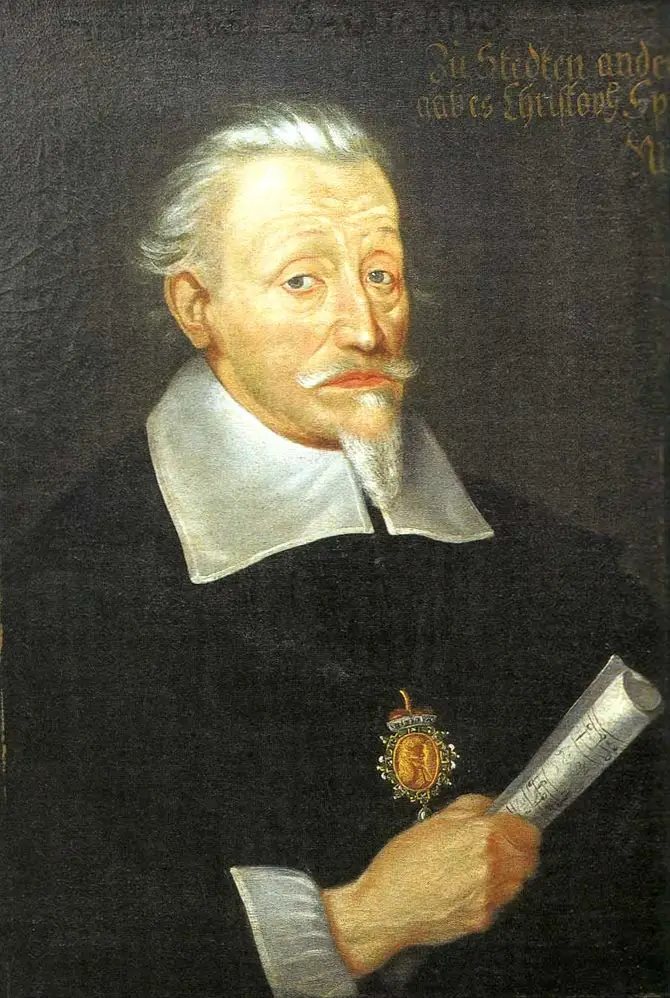Heinrich Schütz
Heinrich Schütz (October 8 (JC), 1585 Köstritz - November 6, 1672 Dresden) was a German composer and organist, generally regarded as the most important German composer before Johann Sebastian Bach and is often considered to be one of the most important composers of the 17th century along with Claudio Monteverdi. He wrote what is thought to be the first German opera, Dafne, performed at Torgau in 1627; however, the music has since been lost. He is commemorated as a musician in the Calendar of Saints of the Lutheran Church on July 28 with Johann Sebastian Bach and George Frederick Handel. He was buried in the Dresden Frauenkirche.
Life
Schütz's musical talents were discovered by Moritz von Hessen-Kassel in 1599. After being a choir-boy he went on to study law at Marburg before going to Venice from 1609-1613 to study music with Giovanni Gabrieli. He subsequently had a short stint as organist at Kassel before moving to Dresden in 1615 to work as court composer to the Elector of Saxony.
He held his Dresden post until the end of his life (sowing the seeds of what is now the Sächsische Staatskapelle Dresden while there), but left Dresden itself on several occasions; in 1628 he went to Venice again, most likely meeting Claudio Monteverdi there—he may have studied with him—and in 1633, after the Thirty Years' War had disrupted life at the court, he took a post at Copenhagen. He returned full time to Dresden in 1641, and remained there for the rest of his life. He died from a stroke in 1672 at the age of 87.
Style
Schütz's compositions show the influence of his teacher Gabrieli (displayed most notably with Schütz's use of resplendent polychoral and concertato styles) and of Monteverdi. Additionally, the influence of the Netherlandish composers of the 16th century is also prominent in his work. His best known works are in the field of sacred music, ranging from solo voice with instrumental accompaniment to a cappella choral music. Representative works include his three books of Symphoniae sacrae, the Psalms of David, the Sieben Worte Jesu Christi am Kreuz (the Seven Last Words on the Cross) and his three Passion settings. Schütz's music, while starting off in the most progressive styles early in his career, eventually grows into a style that is simple and almost austere, culminating with his late Passion settings. Practical considerations were certainly responsible for part of this change: the Thirty Years' War had devastated the musical infrastructure of Germany, and it was no longer practical or even possible to put on the gigantic works in the Venetian style which marked his earlier period.
Schütz was one of the last composers to write in a modal style. His harmonies often result from the contrapuntal alignment of voices rather than from any sense of "harmonic motion"; contrastingly, much of his music shows a strong tonal pull when approaching cadences. His music includes a great deal of imitation, but structured in such a way that the successive voices do not necessarily enter after the same number of beats or at predictable intervallic distances. Schütz's writing often includes intense dissonances caused by the contrapuntal motion of voices moving in correct individual linear motion, but resulting in startling harmonic tension. Above all, his music displays extreme sensitivity to the accents and meaning of the text, which is often conveyed using special technical figures drawn from musica poetica, themselves drawn from or created in analogy to the verbal figures of Classical Rhetoric.
Almost no secular music by Schütz has survived, save for a few domestic songs (arien) and no purely instrumental music at all (unless one counts the short instrumental movement entitled "sinfonia" that encloses the dialogue of Die sieben Worte), even though he had a reputation as one of the finest organists in Germany.
Schütz was of great importance in bringing new musical ideas to Germany from Italy, and as such had a large influence on the German music which was to follow. The style of the north German organ school derives largely from Schütz (as well as from Netherlander Jan Pieterszoon Sweelinck); a century later this music was to culminate in the work of J.S. Bach.
Works
The following are published works. Most of these contain multiple pieces of music; there are over 500 total surviving individual pieces by Schütz.
- Il primo libro de madrigali (first book of madrigals) (Venice, 1611)
- Psalmen Davids (Book 1) (Dresden, 1619)
- Historia der frölichen und siegreichen Aufferstehung ... (History of the Resurrection of Jesus) (Dresden, 1623)
- Cantiones sacrae (Freiberg, 1625)
- Psalmen Davids (Book 2) (Freiberg, 1628)
- Symphoniae sacrae (Book 1) (Venice, 1629)
- Musicalische Exequien (Dresden, 1636)
- Kleine geistliche Konzerte (Book 1) (Leipzig, 1636)
- Symphoniae sacrae (Book 2) (Dresden, 1647)
- Geistliche Chor-Music (Dresden, 1648)
- Symphoniae sacrae (Book 3) (Dresden, 1650)
- Zwölff geistliche Gesänge (Dresden, 1657)
- Psalmen Davids (revision of Book 2) (Dresden, 1661)
Sources
- Manfred Bukofzer, Music in the Baroque Era. New York, W.W. Norton & Co., 1947. ISBN 0393097455
- Basil Smallman: Heinrich Schütz, The Master Musicians, 2000.
- Tamsin (nee Tristan) Jones, "Passions in Perspective: An Analytical Discussion of the Three Passions of Heinrich Schütz (1585-1672) against their Historical and Stylistic Backgrounds" (Ph. D. thesis, University of Birmingham, 2000)
- Heinrich Schütz: "Geistliche Chor-Music, Op. 11." Edited by Andrew Thomas Kuster. Ann Arbor, MI, 2005. ISBN 1411642430.
External links
- Germany Fed. Rep. 1972 stamp devoted to Heinrich Schütz
- Template:ChoralWiki
- Free scores by Heinrich Schütz in the Werner Icking Music Archive
[[Category:Music [[Category:
